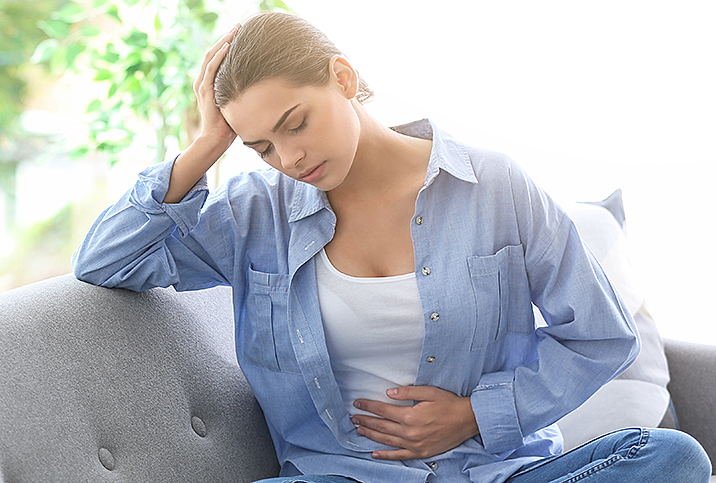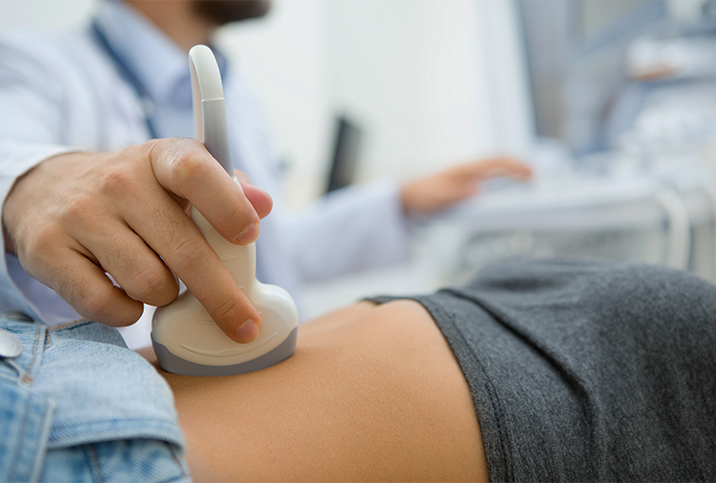What Should You Know About Deep Infiltrating Endometriosis?

Endometriosis is a disease where tissue that resembles endometrial tissue—the endometrium lines the uterus—grows outside the uterus, causing chronic inflammation and adhesions. This disease affects more than 5 million people, causing symptoms and complications such as heavy periods, debilitating pelvic pain and infertility.
Here's what to know about this chronic, life-altering condition, including the signs to look for and the available treatment options.
What is deep infiltrating endometriosis?
Deep infiltrating endometriosis (DIE) is the most aggressive form of the disease, which impacts as many as 20 percent of people with endometriosis, according to Christine Greves, M.D., an OB-GYN at Orlando Health Winnie Palmer Hospital for Women and Babies in Florida.
"It affects the whole pelvis, and it can affect how certain organs—the anatomy—function," Greves said. "It can really negatively impact a person's quality of life."
She highlighted the three main types of endometriosis, which include:
- Superficial endometriosis. In the mildest form of endometriosis, endometrium-like tissues adhere to the surface of the uterus and surrounding organs, such as the ovaries and fallopian tubes.
- Ovarian endometriomas. Benign cysts filled with brown fluid form in the ovaries.
- Deeply infiltrative endometriosis. With DIE, numerous adhesions are embedded 5 millimeters or deeper into pelvic tissues and organs, accompanied by heavy scarring and one or more ovarian endometriomas.
"DIE is defined as endometriosis in which lesions or tissue growth is found deep within the organs rather than on the surface compared to other types of endometriosis," said Mahmud Kara, M.D., the founder and CEO of KaraMD, a supplements manufacturer in Cleveland.
DIE isn't the same as adenomyosis, in which endometrial tissues grow in the uterine muscle, though the two conditions can co-occur.
In most cases of DIE, endometrium-like tissues attach to reproductive organs and the urinary tract or bowels. They can also infiltrate the peritoneum, uterosacral ligament—it helps keep the cervix and uterus in place—rectum, vagina, bladder, appendix or leg nerves, according to the Endometriosis Foundation of America (EFA).
Additionally, they may spread to spaces between the bladder, uterus, rectum or vagina. Rarely, endometriosis strays from the pelvic cavity entirely and makes its way into other organs, including the kidneys, lungs, diaphragm or brain, per EFA.
What causes DIE?
The exact cause of DIE and endometriosis, generally, is unknown. But Greves said genetics, hormones and immune function may contribute, as could intestinal permeability—for those whose bowels are affected.
A 2019 study published in BMC Women's Health identified certain risk factors for DIE compared to other types of endometriosis, Kara noted.
These include:
- Being married
- Older age
- Having siblings
- Prior pregnancies
- History of surgical procedures, such as fibroid removal or dilation
- Presence of other ovulatory or menstrual disorders
What are the symptoms of DIE?
Everyone's experience with endometriosis is different. Furthermore, Greves noted the symptoms don't always follow endometriosis' physical progression. Women with endometriosis may have symptoms that fall outside the range of a particular stage.
"It doesn't always mirror the stage. If someone has horrible, debilitating pain, it doesn't always mean that her pelvis is going to have extensive adhesions and a lot of evidence of endometriosis," she said.
Similarly, a person could have DIE with mild symptoms. However, because lesions tend to attach to highly sensitive areas with many nerves, most people with DIE experience considerable irritation and pain.
Generally, the following symptoms are common, according to Kara, Greves, and Sarah Diemert, N.P., a women's health nurse practitioner in Denver and the director of medical standards integration and evaluation at Planned Parenthood Federation of America.
Common symptoms of DIE include:
- Urinary frequency and urgency
- Painful urination
- Bloody urine
- Pelvic pain
- Painful periods
- Pain during sexual intercourse
- Pain in the flank or lower side of the back
- Uncomfortable bowel movements
- Bloody stool
- Vaginal bleeding after procedures
"In rare cases, patients have no symptoms, but their ureter, [a small tube, or duct, that connects the bladder and kidneys] may become completely closed over time, which can result in loss of kidney function," Diemert said.
Infertility is another prevalent and significant symptom for people women of reproductive age. Although endometriosis affects about 2 percent to 10 percent of the general population of people capable of becoming pregnant, between 25 percent and 50 percent of women who have infertility also have endometriosis, and about half of the people with endometriosis have infertility.
How do you diagnose deep infiltrating endometriosis?
Diagnosing endometriosis is challenging. Its symptoms can resemble other gastrointestinal and gynecological disorders. Also, no noninvasive way exists to definitively diagnose the condition. Research indicates a large percentage of women with endometriosis experience symptoms for years before receiving a diagnosis.
To diagnose DIE, doctors begin by assessing a person's health history and risk factors. They then perform a physical examination to check for pelvic inflammation and pain. They can also perform a transvaginal ultrasound, MRI or laparoscopy to closely examine the reproductive organs.
How do you treat deep infiltrating endometriosis?
Endometriosis is incurable but treatable. Management of DIE often includes pain relievers, such as nonsteroidal anti-inflammatory drugs (NSAIDs).
Hormonal contraceptives, such as the pill or an intrauterine device (IUD) or gonadotropin-releasing hormone (GnRH) agonists, can ameliorate heavy and painful periods for patients who aren't trying to conceive.
Greves and Amir Marashi, M.D., a board-certified OB-GYN with Brooklyn Gynecology Place in New York City and founder of Cerē, which develops physician-designed pleasure products for women, explained hormonal medications are beneficial because they may help slow or stop lesion growth and alleviate symptoms.
Some research indicates long-term dietary changes may help, Greves noted. These dietary changes include eating foods rich in omega-3s and fibrous foods (such as vegetables) and consuming little or no coffee, alcohol or red meat.
What to do when less-invasive treatment doesn’t work?
DIE specifically can be exceedingly difficult to treat, according to Greves, Diemert and Marashi. The standard methods don't always suffice. Marashi said DIE doesn't always respond to medication, and sometimes it is necessary to remove the affected structure or organ—part of the bowel or ureter.
"In most cases of endometriosis, including DIE, medical treatment can be a good modality to decrease or even eliminate the symptoms but not the disease," he continued. "In my experience, the only way you can possibly eliminate the disease is by excision surgery. This is the procedure that removes endometriosis lesions rather than just ablating them."
Ablation for endometriosis, also known as fulguration or cauterization, is a technique that burns the lesions at the most superficial level. It is considered effective for minor endometriosis but less so for DIE. Ablation may provide some initial relief, but the lesions are not removed, so they may grow back. This is why most experts recommend excision. Excision is also the only way to remove ovarian cysts.
With either operation, as with any surgery, there are risks of bleeding and infection, Marashi said. Depending on the lesion's location, surgery could injure the affected area. Finding a surgeon who specializes in excision can reduce the risk of adverse outcomes.
Additionally, Diemert said, growths can reappear after surgery. Medications can potentially diminish the odds of a recurrence, but many people need multiple operations. Working with a qualified surgeon can lessen the chances of recurrent disease.
"As a last resort, some people have a hysterectomy—removing the uterus and sometimes the ovaries—though it's impossible to become pregnant after that," Diemert said.
What are the complications of DIE?
DIE's typical symptoms can be debilitating if not incapacitating. Unaddressed, it can produce even more significant consequences, such as a frozen pelvis or spontaneous hemoperitoneum.
Frozen pelvis
Deep infiltrating endometriosis can create such extensive inflammation and scar tissue that organs fuse. It may be difficult to discern one structure from another. In a healthy person, organs have some freedom of movement. With a frozen pelvis, they are locked in place and sometimes incorrectly positioned.
This effect is particularly painful during ovulation when the ovaries swell, during sexual intercourse or around menstruation.
Spontaneous hemoperitoneum
Sometimes referred to as intra-abdominal hemorrhage or intraperitoneal hemorrhage, spontaneous hemoperitoneum is a rare, life-threatening complication. It is a type of internal bleeding where blood collects in the space between the organs and the lining of the abdomen, which houses the intestines, stomach and liver.
It can occur when an endometrioma—a cyst-like lesion—ruptures or a blood vessel bursts. Symptoms may include:
- Severe, sudden abdominal pain
- Swollen abdomen
- Rapid heartbeat and breathing
- Clammy skin
- Cold skin
- Confusion
- Sweating
If you experience any of these symptoms, call your doctor immediately.
While DIE doesn’t have a cure, it is treatable. Your doctor may recommend hormone treatment, pain relievers or a more invasive option.


















